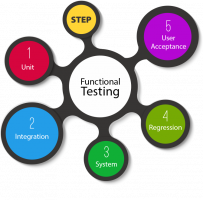Things you should know about functional testing
- 2020-12-10 20:31:47
- philip
- Original 2259
Things you should know about functional testing
Functional Testing Disadvantages
1. Large number of test cases
2. Test cases may produce a lot of redundancy
3. The coverage rate cannot reach 100%
Functional Testing Advantages
It has nothing to do with how the software is implemented. If the implementation changes, functional test cases are still available
Method: (commonly used)
- Functional decomposition
- Equivalence class division
- Boundary value analysis
- Causality Diagram
1. Functional decomposition:
Through functional decomposition, the content of software functional testing can be clarified, making software functional testing measurable, which is conducive to testing supervision and management.
2. Equivalence class division: divide the input or output fields of the program into different intervals or different data classes in order to derive test cases
Effective equivalence class: a collection of input data that is reasonable and meaningful to the needs of the program
Invalid equivalence class: a collection of unreasonable and meaningless data for the input or output of the program
Used to check the program's ability to handle invalid data
3. Boundary value analysis:
Boundary value analysis is a supplement to the equivalence class. Defects are often missed in the corners and clustered on the boundary. It is easier to find errors in selecting the boundary area of the input condition as the test data than the intermediate data.
4. Causality diagram:
Considering the interconnection and combination of input conditions, the cause and effect diagram finally generates a judgment table, which is suitable for checking various combinations of program input conditions
Judgment table composition: condition stake, action stake, condition item, action item.
5. Other test methods: wrong speculation
Test process
1. Make a test plan
2. Design test cases, test cases: it is an example used to check whether the software meets the requirements. The basic elements include purpose, preconditions, input data or actions, and expected results
3. If the "startup criteria" are met, then perform the test
4. Write test report
5. If the "completion criterion" is met, then end the testTest start criteria:
- The test plan has been developed and approved;
- The test case has been designed and approved;
- The tested object has been developed and is waiting for testing.
Test start criteria:
- The pass rate of functional test cases reaches 100%;
- When the pass rate of non-functional test cases reaches 90%.
- The "defect density during testing period" within n adjacent CPU hours is all lower than a certain value m. For example, n is greater than 10 and m is less than or equal to 1.
Things testers should know:
- Testing can improve the quality of software, but improving quality cannot rely on testing
- The test can prove the existence of defects, but cannot prove that the software does not exist
- The 80-20 principle: 80% of the defects exist in 20% of the modules, and the modules that often make mistakes will often make mistakes after they are corrected.
Products
- ZDOO
- ZDOO Cloud
Support
- Book a Demo
- Tech Forum
- GitHub
- SourceForge
About Us
- Company
- Privacy Policy
- Term of Use
- Blogs
- Partners
Contact Us
- Leave a Message
- Email Us: support@zentaoalm.com







